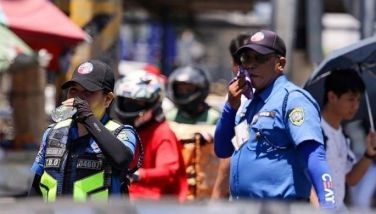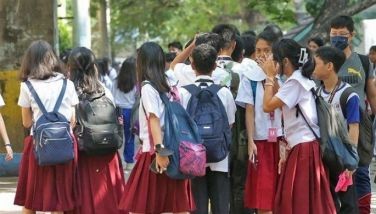Yearender: Climate change tops DENR priority in 2007
As world leaders attempted but failed to formulate a post-Kyoto Protocol agreement to deal with global warming, the Philippines has been ranked as the top victim of extreme weather events in the world in 2006.
Based on the international report “Global Climate Risk Index 2006,” which environment and development organization Germanwatch and Munich Reinsurance presented during the historical United Nations-initiated climate summit in Bali, Indonesia, the Philippines was the most affected among the countries that suffered storms, floods, and extreme weather events.
Prior to this report, various environmental groups have repeatedly warned the government about the
The government, for its part, took several initiatives to boost efforts to curb the anticipated effects of climate change on the country.
On
In February, Mrs. Arroyo issued Administrative Order 171 creating a Presidential Task Force on Climate Change (PTFCC) that seeks to address and mitigate the impact of climate change in the country.
The PTFCC is to conduct rapid assessment on the impact of climate change in the Philippine setting, especially on the most vulnerable sectors or areas like water, agriculture, coastal areas, as well as on terrestrial and marine ecosystems.
It will also ensure strict compliance to air emission standards and act with urgency to combat deforestation and environmental degradation as well as apprehend violators.
Last October, the PTFCC came up with the Philippine Climate Change Response Action Plan (PCCRAP), which contains the task force’s “preliminary substantive program elements.”
Former Department of Environment and Natural Resources (DENR) secretary Angelo Reyes, who is now the chief of the Department of Energy (DoE), heads the PTFCC.
Meanwhile, Reyes’ successor, former Manila mayor Lito Atienza, issued DENR Special Order 2007-653, creating the Advisory Council on Climate Change Mitigation, Adaptation and Communication.
The initial executive order creating the PTFCC had the DENR Secretary as its head, but the President later modified the composition of the task force, designating instead the DOE Secretary as PTFCC chief.
During the recent climate change meeting in
In fact, he noted, the Philippines is number eight in the world in terms of CDM projects since the country has, to date, a total of 14 projects registered with the CDM executive board in Switzerland.
The government, through DENR, had also set its action plan on climate change mitigation that included the improvement in the management of forests and grasslands and air quality.
Its adaptation measures include protection of water aquifer, conduct of massive information and education campaign, expansion of capacities of river basins, establishment of protection measures for coastal areas, determination of areas most vulnerable to natural hazards “to forewarn people,” and strengthening the protection of ecosystems and vulnerable species.
Tress for life
Last June, in celebration of World Environment Day, government and different civil society organizations launched an ambitious program that aims to plant 20 million seedlings nationwide.
The project was supposed to boost and sustain the Green Philippine Highways program of Reyes. The Green Philippine Highways in August 2006 succeeded in planting more than 800,000 seedlings along 4,181 kilometers of Philippine highways.
The DENR and Green Army Foundation signed a memorandum of agreement that would repeat the simultaneous planting of seedlings across the country under the Trees for Life project.
However, unofficial data from the DENR, which showed the accomplishment report of the Trees for Life project from July to November 2007, indicated that there were only a total of 9.6 million seedlings planted, covering an area of 8,000 hectares and distance of 603 kilometers nationwide.
Of the total count, some 4 million seedlings were planted in 3,000 hectares of protected areas, critical watersheds, and open lands; 1.8 million seedlings in 1, 437 hectares of mangrove and coastal areas; 3.4 million seedlings in 3,262 hectares of agroforestry areas and fruit trees; and 300,223 seedlings in 259 hectares of urban parks and “green” campuses.
Climate ‘hotspot’
Two months before the Trees for Life project was launched, Greenpeace released a briefing paper, which approximated that close to 700 million square meters of land area in the country will gradually be submerged as global temperatures increase due to climate change, causing water expansion.
The study, titled “The Philippines: A Climate Hotspot,” presented an overview of how extreme weather events and sea level rise threaten the country’s people, economy, species, and ecosystems.
Greenpeace Southeast Asia climate and energy campaigner Abigail Jabines stressed that their study revealed that “the entire
Conservative estimates by Greenpeace claimed that an indicative one-meter rise in sea level may affect 64 out of 81 provinces, which cover about 703 of the total 1,610 municipalities, and submerge almost 700 million square meters of land across the country by 2095 to 2100.
At the same time, the Greenpeace study identified the top 20 provinces in the country which are vulnerable to a one-meter rise in sea level.
These are Sulu,
Top victim
In fact, according to Germanwatch’s Global Climate Risk Index, the Philippines was the world’s top climate victim in 2006 because it was the most affected among the countries that suffered storms, floods, and extreme weather events in that year. The
The report said that in the
The report also said that in 2006, some 8,568,968 Filipinos were affected by extreme weather events.
The report identifies the countries most affected by extreme weather events based on the total number of deaths, deaths per 100,000 inhabitants, losses in US dollars, and losses per unit of the gross domestic product.
Asian countries dominated the ranking of the most affected countries in this climate risk index worldwide.
‘Walk the talk’
Environmentalists have criticized the small steps taken by the government to address the urgent issue on climate change impacts.
They said the
Studies showed that the Philippines has a total of nearly 80,000-megawatt wind, biomass, and mini-hydro energy, as it likewise has a solar energy potential of 1,500 hours of power annually at 5 kilowatt-hour per square meter per day.
But DoE data indicated the
Meantime, DENR Secretary Atienza yesterday enjoined Filipinos to commit themselves to taking steps to reverse the impact of environmental degradation as the nation welcomed the New Year.
Atienza also vowed that the DENR would vigorously pursue and strengthen its partnership with local government units, non-government organizations and the private sector this year in order to attain and sustain better results on environmental conservation.
- Latest
- Trending





























